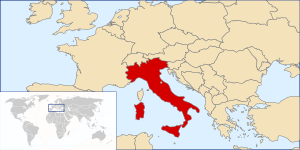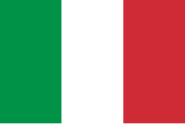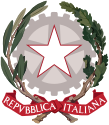The following outline is provided as an overview of and topical guide to Italy:

Italy is a unitary parliamentary republic in South-Central Europe, located primarily upon the Italian Peninsula. It is where Ancient Rome originated as a small agricultural community about the 8th century BC, which spread over the course of centuries into the colossal Roman empire, encompassing the whole Mediterranean Basin and spreading Roman culture and civilization across the empire. This civilization was so influential that parts of it survive in modern law, administration, philosophy and arts, providing the groundwork that the Western world is based upon.
General reference
edit- Name of Italy
- Pronunciation: /ˈɪtəli/
- Italian: [iˈtaːlja]
- Common English country name: Italy
- Official English country name: Italian Republic[1]
- Common endonym(s): Italia
- Official endonym(s): Repubblica italiana
- Adjectival(s): Italian
- Demonym(s): Italian
- Pronunciation: /ˈɪtəli/
- Date and time notation in Italy
- International rankings of Italy
- ISO country codes: IT, ITA, 380
- ISO region codes: See ISO 3166-2:IT
- Internet country code top-level domain: .it
Geography of Italy
edit- Italy is:
- Location:
- Northern Hemisphere and Eastern Hemisphere
- Eurasia
- Time zone: Central European Time (UTC+01), Central European Summer Time (UTC+02)
- Extreme points of Italy
- North: Glockenkarkopf
- South: Punta Pesce Spada
- East: Capo d'Otranto
- West: Rocca Bernauda
- High: Monte Bianco 4,810 m (15,781 ft)
- Low: Contane on the Po Delta −3.2 m (−10 ft)
- Land boundaries: 1,899 km
- Switzerland (outline) 740 km
- France (outline) 488 km
- Austria (outline) 430 km
- Slovenia (outline) 199 km
- San Marino (outline) 39 km
- Vatican City (outline) 3 km
- Coastline: 7,600 km
- Mediterranean Sea: Ligurian, Tyrrhenian, Ionian, Adriatic, Sardinian seas
- Population of Italy: 58,968,501 people (2024/04/30 estimate)[2] - 25th most populous country
- Area of Italy: 301,338 km2 (116,347 sq mi) - 71st largest country
- Atlas of Italy
Environment of Italy
edit- Climate of Italy
- Conservation in Italy
- National parks of Italy
- Marine protected areas of Italy
- Regional parks of Italy
- Ecoregions in Italy
- Geology of Italy
- Natural hazards in Italy
- Wildlife of Italy
Geographic features of Italy
edit- Beaches in Italy
- Canals in Italy
- Caves in Italy
- Earthquakes in Italy
- Glaciers of Italy
- Islands of Italy
- Lakes of Italy
- Mountains of Italy
- Rivers of Italy
- Valleys of Italy
- World Heritage Sites in Italy (See also Transboundary sites)
Regions of Italy
editAdministrative divisions types
editStatistical divisions of Italy
editGroups of regions, regions, and provinces/metropolitan cities of Italy
edit
|
|
|
Comuni (municipalities) of Italy
editDemographics of Italy
editNeighbors of Italy
editItaly shares its north border with:
- Austria
- France
- Slovenia
- Switzerland shares Italy's northern border, and Campione d'Italia is an Italian exclave in Switzerland.
Independent states surrounded by Italy (otherwise within Italy's borders) include:
Government and politics of Italy
edit- Form of government: parliamentary multi-party representative democratic republic
- Capital of Italy: Rome
- Corruption in Italy
- Elections in Italy
- Orders, decorations, and medals of Italy
- Political ideologies in Italy
- Political parties in Italy
- Political scandals of Italy
- Public administration in Italy
- Racism in Italy
- Taxation in Italy
Branches of the government of Italy
editHead of State
editExecutive branch
edit- Prime Minister of Italy (a.k.a. President of the Council of Ministers, see also Head of government)
- Council of Ministers of Italy
Legislative branch
editJudicial branch
edit- Judiciary of Italy
- Supreme Court of Cassation (Corte Suprema di Cassazione)
- Constitutional Court of Italy
Local government
editForeign relations of Italy
editInternational organization membership
editThe Italian Republic is a member of:[3]
Law and order in Italy
edit- Law of Italy
- Crime in Italy
- Human rights in Italy
- Judiciary of Italy
- Law enforcement in Italy
Military of Italy
edit- Armed forces of Italy:
- Army of Italy: Esercito Italiano
- Navy of Italy: Marina Militare
- Air force of Italy: Aeronautica Militare
- Gendarmerie of Italy: Carabinieri
- Guardia di Finanza
- Military history of Italy
- Wars involving Italy
History of Italy
editBy period
edit- Prehistoric Italy
- Ancient peoples of Italy
- Cisalpine Gaul
- Etruscan civilization
- Italic peoples
- Ligures
- Nuragic civilization
- Magna Graecia (8th–3th centuries BC)
- Italy during Roman times (8th century BC – 6th century AD)
- Italy in the Middle Ages (6th–14th centuries)
- Ostrogothic Kingdom
- Byzantine Italy
- Kingdom of the Lombards
- Papal States (756 – 1870)
- Holy Roman Empire
- Sardinian medieval kingdoms
- Arabs
- Normans
- Kingdom of Sicily (founded in 1130)
- Guelphs and Ghibellines
- Kingdom of Naples (founded in 1282)
- Italian city-states
- Duchy of Savoy
- Italian Renaissance (14th–16th centuries)
- Italian Wars (1494–1559)
- History of early modern Italy
- Italian unification (1814 –1861)
- Italian irredentism
- History of the Kingdom of Italy (1861–1946)
- History of the Italian Republic (1946 – present)
By region
edit- History of Florence
- History of Milan
- History of Naples
- History of Rome
- History of Tuscany
- History of Palermo
By subject
edit- Economic history of Italy
- Genetic history of Italy
- Historical states of Italy
- Military history of Italy
- Music history of Italy
- History of coins in Italy
- History of Italian citizenship
- History of Italian culture (1700s)
- History of Italian fashion
- History of Italian flags
- History of rail transport in Italy
- History of Roman Catholicism in Italy
- History of the Jews in Italy
- LGBT history in Italy
- Name of Italy
- Postage stamps and postal history of Italy
Cultural history
editCulture of Italy
edit- Culture of Rome
- Architecture of Italy
- Ancient Roman architecture
- Italian Gothic architecture
- Italian Renaissance and Mannerist architecture
- Italian Baroque architecture
- Italian Neoclassical architecture
- Italian modern and contemporary architecture
- North-Western Italian architecture
- List of Italian architects
- List of castles in Italy
- List of cathedrals in Italy
- List of libraries in Italy
- List of palaces in Italy
- Cuisine of Italy
- Gardens in Italy
- Italian nationalism
- Italophilia
- Languages of Italy
- Media in Italy
- Mythology of Italy
- Monuments of Italy
- Museums in Italy
- National symbols of Italy
- Philosophy
- Public holidays in Italy
- Traditions of Italy
- Units of measurement
- World Heritage Sites in Italy (See also Transboundary sites)
Art in Italy
edit- Art in Italy
- Italian ballet
- Cinema of Italy
- Italian design
- Italian fashion
- Literature of Italy
- Folklore of Italy
- Music of Italy
- Sculpture of Italy
- Theatre in Italy
People in Italy
edit- Italians
- People from Italy
- Italian actors
- Italian actresses
- Italian architects
- Italian women artists
- Italian chefs
- child actors
- Italian classical composers
- Italian comedians
- Italian composers
- Italian designers
- Italian explorers
- Italian film directors
- Italian inventors
- Italian journalists
- Italian lawyers
- Italian mathematicians
- Italian Nobel laureates
- Italian painters
- Italian philosophers
- Italian-language poets
- Italian politicians
- Italian scientists
- Italian women writers
- Italian writers
- People from Italy
- Italian diaspora
- Immigration to Italy
- Monarchy of Italy
- Nobility of Italy
- Social class in Italy
- Women in Italy
Ethnic groups in Italy
edit- Algerians in Italy
- Arabs in Italy
- Arbëreshë people
- Armenians in Italy
- Australians in Italy
- Bangladeshis in Italy
- Bulgarians in Italy
- Cape Verdeans in Italy
- Chinese people in Italy
- Congolese people in Italy
- Croats of Italy
- Cuban people in Italy
- Dominican people in Italy
- Egyptians in Italy
- Ghanaian people in Italy
- Greeks in Italy
- Indians in Italy
- Moroccans in Italy
- Nepalis in Italy
- Nigerian people in Italy
- Pakistanis in Italy
- Peruvians in Italy
- Romani people in Italy
- Romanians in Italy
- Senegalese people in Italy
- Serbs in Italy
- Somali people in Italy
- Swiss people in Italy
- Sri Lankans in Italy
- Tamils in Italy
- Tunisian people in Italy
- Turks in Italy
- Ukrainians in Italy
- Uruguayans in Italy
Religion in Italy
edit- Bahá'í Faith in Italy
- Buddhism in Italy
- Christianity in Italy
- Apostolic Church in Italy
- Assemblies of God in Italy
- Baptist Evangelical Christian Union of Italy
- Catholic Church in Italy
- Eastern Orthodoxy in Italy
- Evangelical Reformed Baptist Churches in Italy
- Federation of Evangelical Churches in Italy
- List of Catholic dioceses in Italy
- Lutheran Evangelical Church in Italy
- Methodist Evangelical Church in Italy
- Protestantism in Italy
- Old Catholic Church in Italy
- Oriental Orthodoxy in Italy
- Hinduism in Italy
- Islam in Italy
- Judaism in Italy
- Sikhism in Italy
- Taoist Church of Italy
Sport in Italy
edit- American football
- Athletics in Italy
- Auto racing
- Baseball
- Basketball
- Cricket
- Cycling
- Futsal in Italy
- Golf
- Ice hockey in Italy
- Italy at the Olympics
- Rugby football
- Tennis in Italy
- Volleyball
Basketball in Italy
edit- Italian basketball league system
- Italian Basketball Federation
- Lega Basket Serie A
- Italy men's national basketball team
- Italy women's national 3x3 team
- Italy women's national basketball team
- Italy women's national 3x3 team
- Lega Basket Femminile
Football in Italy
edit- Association football league system in Italy note: superseded by Italian football league system
- Football derbies in Italy
- Football records in Italy
- Italian Football Hall of Fame
- List of football clubs in Italy
- List of football stadiums in Italy
- Italy national football team
- Supercoppa Italiana
Other sports popular in Italy
editEconomy and infrastructure of Italy
edit- Economic rank, by nominal GDP (2018): 8th (eighth)
- Agriculture in Italy
- Banking in Italy
- Telecommunications in Italy
- Companies of Italy
- Currency of Italy: Euro (see also: Euro topics)
- Former currency: Italian lira
- ISO 4217: EUR
- Economic history of Italy
- Italian government debt
- Italian wine
- Energy in Italy
- Gambling in Italy
- Labor policy in Italy
- Exports of Italy
- List of Italian brands
- Italian regions by GDP
- Manufacturing in Italy
- Made in Italy
- Science and technology in Italy
- Southern question
- Taxation in Italy
- Tourism in Italy
- Trade unions in Italy
- Water supply and sanitation in Italy
- Welfare in Italy
Transport in Italy
editLocal economies
editEducation in Italy
editHealth in Italy
editSee also
edit- Index of Italy-related articles
- List of international rankings
- Member state of the European Union
- Member state of the Group of Twenty Finance Ministers and Central Bank Governors
- Member state of the North Atlantic Treaty Organization
- Member state of the United Nations
- Outline of Europe
- Outline of geography
References
edit- ^ The English name of the Italian state used in the English text of the Treaty of Lisbon.
- ^ "Monthly Demographic Balance".
- ^ "Italy". The World Factbook. United States Central Intelligence Agency. July 15, 2009. Retrieved July 23, 2009.
- ^ Bloom, Harold (1994). The Western Canon. Harcourt Brace. ISBN 9780151957477. See also Western canon for other "canons" that include the Divine Comedy.
- ^ Singer, C. (1941). "A Short History of Science to the Nineteenth Century". Clarendon Press: 217.
{{cite journal}}: Cite journal requires|journal=(help) - ^ Whitehouse, D. (2009). Renaissance Genius: Galileo Galilei & His Legacy to Modern Science. Sterling Publishing. p. 219. ISBN 978-1-4027-6977-1.
- ^ Thomas Hobbes: Critical Assessments, Volume 1. Preston King. 1993. p. 59
- ^ Disraeli, I. (1835). Curiosities of Literature. W. Pearson & Company. p. 371.
- ^ Kemp, Martin (2003). "Leonardo da Vinci". Grove Art Online. Oxford: Oxford University Press. doi:10.1093/gao/9781884446054.article.T050401. ISBN 978-1-884446-05-4. (subscription or UK public library membership required)
- ^ "Top 10 most Beautiful Cities in the World 2017". 28 July 2016.
- ^ "Top 10 most Beautiful Cities in the World 2018". 2 September 2018.
External links
edit- Italy travel guide from Wikivoyage
- Country profiles
- by the BBC News
- by the CIA Factbook
- by the CIA World Leaders
- by the Economist
- by the U.S. Department of State
- by the World Bank
- Government
- President of the Republic of Italy
- Chamber of Deputies
- Court of Accounts
- Ministry of Foreign Affairs
- Ministry of Education: International Exchanges
- Ministry of Labour and Social Welfare
- Ministry of Justice
- Public institutions
- National Statistics Office
- ENIT Italian State Tourism Board
- ENIT North America
- Italian Railways
- Italian National and Regional Parks
- Other

